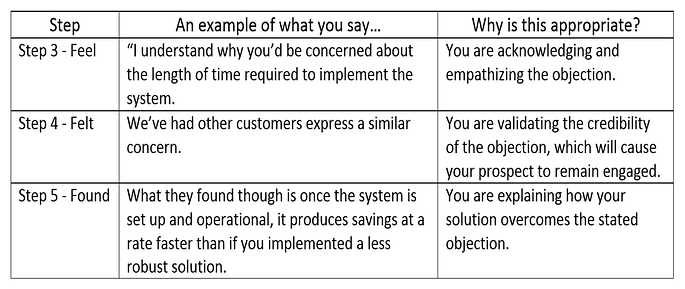Imagine you are part of an experiment about human behavior to see how people react in unfamiliar circumstances. You are blindfolded, led to a car, put on a plane and flown to a city to which you had never been before. Upon arriving in this new place, you are driven to a street corner in the city and dropped off with instructions to remove your blindfold. What would you do first? Many people would look around for any familiar landmarks. Others would look for someone to ask where they are. Asking where you are is the first step to overcoming objections – also known as the trial close.
Trial closing – Step 1
Trial closing is the salesperson’s most valuable tool. During your time with a prospect, you should constantly be asking questions to determine if you are connecting with the prospect, understanding their needs and/or clearly communicating how your solutions will achieve their objectives. These questions also help you understand their “temperature” – are they resistant, interested, ready to buy?
In our training we ask salespeople for examples of a trial close. Frequently they’ll say something like, “If I can get you the price you want, will you buy?” or “Would you like to lease or purchase?” These examples are closer to a close (asking for the sale) than a trial close. The trial close is an opinion-asking question that informs salesperson where they are in the sales process. Some example trial closing questions are:
- How do you feel about what we have discussed so far?
- How does what we’ve talked about sound to you?
- Based on the information you’ve received so far, how do you like what we have shown you?
- If you could wave your magic wand what changes would you make to our proposal?
Asking good trial closing questions often results in the prospect raising an objection. In a lot ways, objections are good because they help you understand what’s important to the prospect and what impediments there may be to making the sale. After all, if you have no idea what might be a concern to your prospect, when it comes time to ask for the sale, you’ll likely get a “no” response.
Preparing for objections – Step 2
Naturally you will be more confident and able to execute this 5-step process when you have a good idea of what the objections might be. Thinking and preparing ahead of time to predict prospects’ objections to your solution will enable you to identify and articulate with confidence the Feel-Felt-Found method (steps 3-5) described next. We encourage you to take the time to predict objections and formulate your Feel-Felt-Found responses.
Feel – Felt – Found…Overcoming the objection
Steps 3-5 of the 5-step process is to use the Feel-Felt-Found method for responding to a prospect’s concern or objection. Feel-felt-found has proven time and again to be an effective way of acknowledging and validating the prospect’s concern, and then overcoming the objection with a valid benefit.
Use trial closing questions to uncover objections and don’t be afraid of them. Predict what those objections might be ahead of time and prepare your Feel-Felt-Found responses that overcome objections on your way to making the sale.






Agree, disagree, or just have something to add?
Leave a comment below.